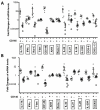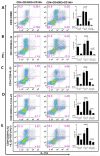MCAM-expressing CD4(+) T cells in peripheral blood secrete IL-17A and are significantly elevated in inflammatory autoimmune diseases
- PMID: 21959269
- PMCID: PMC3223259
- DOI: 10.1016/j.jaut.2011.09.003
MCAM-expressing CD4(+) T cells in peripheral blood secrete IL-17A and are significantly elevated in inflammatory autoimmune diseases
Abstract
Th17 cells are a subset of CD4(+) T cells characterized by production of IL-17 and are known to be key participants in inflammatory reactions and various autoimmune diseases. In this study we found that a subset of human CD4(+) T cells expressing MCAM (CD146) have higher mRNA levels of RORC2, IL-23R, IL-26, IL-22, IL-17A, but not IFN-γ, compared to CD4(+) T cell not expressing CD146. Upon TCR stimulation with CD3/CD28, CD4(+)CD146(+) T cells secrete significantly more IL-17A, IL-6, and IL-8 than do CD4(+)CD146(-) T cells. Low frequencies of CD4(+)CD146(+) T cells are found in the circulation of healthy adults, but the frequency of these cells is significantly increased in the circulation of patients with inflammatory autoimmune diseases including Behcet's, sarcoidosis and Crohn's disease. Patterns of gene expression and cytokine secretion in these cells are similar in healthy and disease groups. In Crohn's disease, the increase in CD4(+)CD146(+) cells in the circulation correlates with disease severity scores. These data indicate that expression of CD146 on CD4(+) T cells identifies a population of committed human Th17 cells. It is likely the expression of CD146, an endothelial adhesion molecule, facilitates adherence and migration of Th17 cells through the endothelium to sites of inflammation.
Published by Elsevier Ltd.
Figures







References
-
- Mosmann TR, Cherwinski H, Bond MW, Giedlin MA, Coffman RL. Two types of murine helper T cell clone. I. Definition according to profiles of lymphokine activities and secreted proteins. Journal of immunology. 1986;136:2348–57. - PubMed
-
- Killar L, MacDonald G, West J, Woods A, Bottomly K. Cloned, Ia-restricted T cells that do not produce interleukin 4(IL 4)/B cell stimulatory factor 1(BSF-1) fail to help antigen-specific B cells. Journal of immunology. 1987;138:1674–9. - PubMed
-
- Sakaguchi S, Sakaguchi N, Asano M, Itoh M, Toda M. Immunologic self-tolerance maintained by activated T cells expressing IL-2 receptor alpha-chains (CD25). Breakdown of a single mechanism of self-tolerance causes various autoimmune diseases. Journal of immunology. 1995;155:1151–64. - PubMed
-
- Bendelac A, Killeen N, Littman DR, Schwartz RH. A subset of CD4+ thymocytes selected by MHC class I molecules. Science. 1994;263:1774–8. - PubMed
-
- Weiner HL. Induction and mechanism of action of transforming growth factor-beta-secreting Th3 regulatory cells. Immunol Rev. 2001;182:207–14. - PubMed
Publication types
MeSH terms
Substances
Grants and funding
LinkOut - more resources
Full Text Sources
Other Literature Sources
Medical
Research Materials

